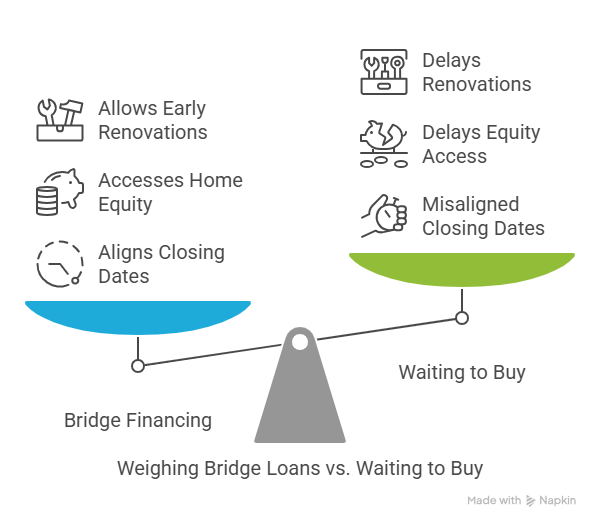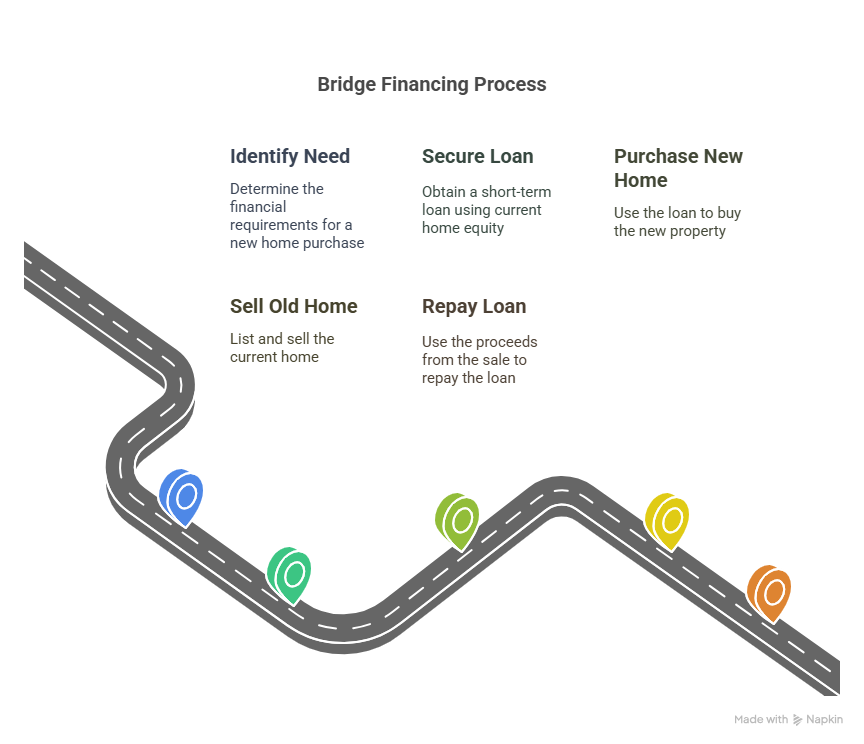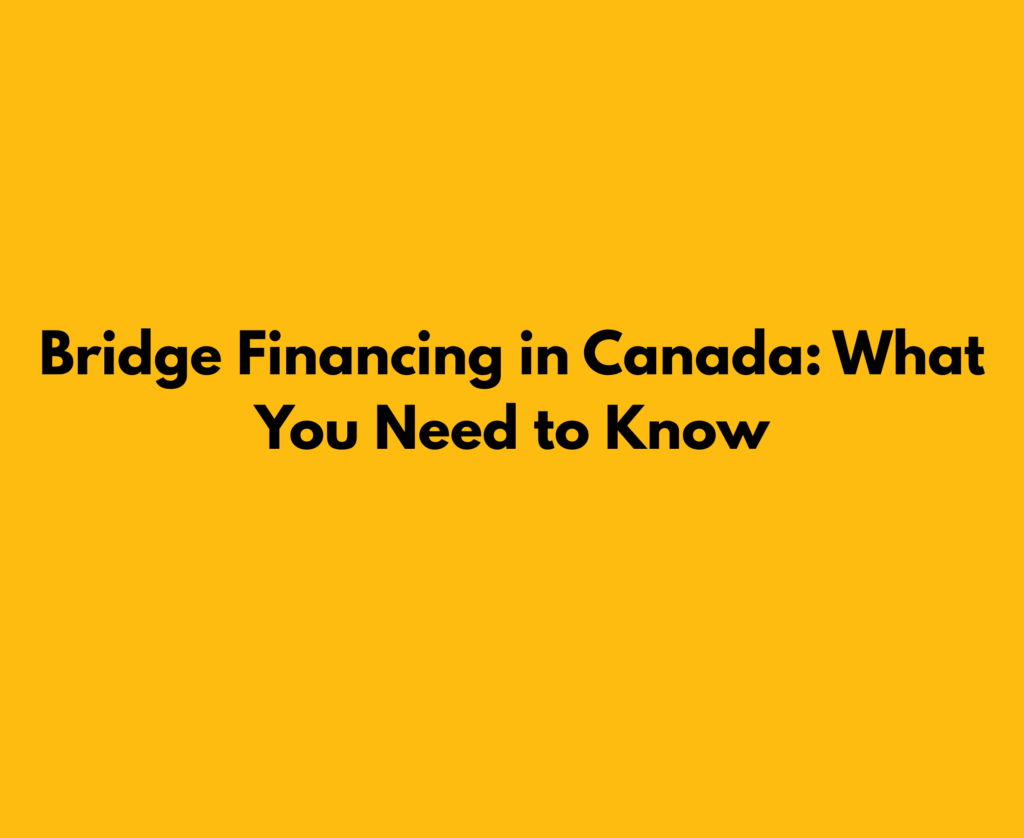Bridge Financing in Canada: What You Need to Know
Buying a new home is exciting… until the timelines don’t line up. You’ve found your dream home, but your current one hasn’t sold yet. That’s where bridge financing comes in, and trust me, it can be a total game changer.
But with big banks like TD, comparison platforms like Ratehub, and financial marketplaces like WOWA all offering options, how do you choose? In this article, I’ll walk you through everything you need to know in plain English to help you understand how bridge loans work, who offers what, and which option is right for your unique situation.
Let’s dive into it..
What Is Bridge Financing, Anyway?
Bridge financing is exactly what it sounds like: it “bridges” the gap between buying your next home and selling your current one.
Think of it like a rope swing over a river. You need something to get you from one side (your old home) to the other side (your new home), and that rope swing is your short-term loan. You use the equity in your current home as collateral, and the loan gets paid off as soon as your home sale closes.
Simple, right?
Why People Use Bridge Loans in Canada
You might be wondering, “Why not just wait to buy until I sell?” Valid point. But in reality, life doesn’t always move that neatly. Here are a few reasons Canadians turn to bridge financing:
-
🔑 Closing dates don’t align — Your new home is ready in 30 days, but your current buyer needs 60.
-
💰 You need your current home’s equity for the down payment.
-
🛠️ You want to do renovations on the new place before moving in.
-
🧘 You just don’t want the stress of rushing two closings at once.
Bridge loans give you breathing room. And in a tight real estate market, that’s gold.

Bridge Financing Basics: How It Works
Here’s the quick and dirty breakdown:
-
Loan Term: Short — usually 30 to 120 days.
-
Repayment: Due when your old home sells.
-
Security: Equity from your current home.
-
Loan Size: Typically the amount you need for the new down payment, legal fees, or moving costs.

TD Bridge Financing: The Bank-Backed Option
✅ What They Offer
TD Canada Trust offers bridge financing if you’re getting your mortgage through them. That means you’ll need a TD mortgage or a TD Home Equity FlexLine for your new purchase.
📄 Eligibility Requirements
-
A signed purchase agreement for your new home
-
A signed sale agreement for your current home
-
Strong credit and TD mortgage approval
💸 Costs and Terms
-
Term: Up to 90 days
-
Rates: Similar to open mortgage rates (usually higher than closed mortgages)
💡 Pros
-
Established process and in-house underwriting
-
Easy if you’re already banking with TD
-
Tied directly to your TD mortgage product
⚠️ Cons
-
Only available if TD holds your new mortgage
-
Less flexibility with terms or structure
-
Doesn’t publicly disclose detailed fees
Ratehub Bridge Financing: The Comparison King
🧐 What It Is
Ratehub isn’t a lender — it’s a comparison platform that connects you with different lenders, both big banks and brokers.
📄 Eligibility Requirements
-
Firm purchase and sale agreements
-
Good credit history
-
Sufficient equity in your current home (usually over 20%)
💸 Costs and Terms
-
Term: Usually 30–120 days
-
Interest: Around Prime + 2%
-
Extra costs: Potential legal and admin fees
💡 Pros
-
Get multiple quotes to compare rates
-
More transparent about costs than some banks
-
Works with multiple lenders, increasing approval odds
⚠️ Cons
-
No one-size-fits-all — depends on the lender
-
May require more legwork (uploading docs, applying with different lenders)
WOWA Bridge Financing: The Marketplace Matchmaker
🔎 What It Offers
WOWA connects you with bridge loan lenders, both institutional and private, for when traditional financing falls short.
📄 Eligibility Requirements
-
Signed purchase and sale agreements
-
Strong credit, but also works with alternative lenders for those with challenges
-
Home equity is still key
💸 Costs and Terms
-
Term: Up to 120 days
-
Interest: Prime + 2% or higher
-
Private options available if you don’t qualify with banks
💡 Pros
-
Access to private lenders if you don’t qualify with A-lenders
-
Flexible options for borrowers with bruised credit or self-employed income
-
Transparent estimates and loan calculators
⚠️ Cons
-
Private lenders charge higher rates and fees
-
Some offers may require additional due diligence
-
Not an actual lender — acts as a gateway
Head-to-Head Comparison: TD vs. Ratehub vs. WOWA
| Feature | TD | Ratehub | WOWA |
|---|---|---|---|
| Lender Type | Traditional Bank | Comparison Platform | Marketplace (Brokers/Private) |
| Term Length | Up to 90 Days | 30–120 Days | Up to 120 Days |
| Interest Rates | Open mortgage rates | Prime + 2% (estimated) | Prime + 2% or higher |
| Requires Mortgage With Them? | Yes | No | No |
| Alternative Lending? | No | Limited | Yes |
| Transparency | Moderate | High | High |
| Best For… | TD Mortgage Clients | Rate Shoppers | Complex Situations |
So… Which One Should You Choose?
Here’s the bottom line:
-
👉 Go with TD if you’re already getting your mortgage with them and want a streamlined process.
-
👉 Use Ratehub if you want to shop around for rates, compare lenders, and find the best bank-approved option.
-
👉 Explore WOWA if your situation is unique — maybe you’re self-employed, your credit isn’t perfect, or you want alternative solutions like private lenders.
There’s no one-size-fits-all. Your best move? Get a quote from more than one source. That’s how you’ll save money, reduce risk, and move into your new home stress-free.
Conclusion: Is Bridge Financing Worth It in 2025?
Absolutely — when used wisely.
Bridge financing gives you the breathing room to move confidently into your next chapter. Just like a real bridge, it’s not the destination — it’s the connector that makes the journey possible.
Before signing any paperwork, always:
-
✅ Get pre-approved
-
✅ Understand the fees
-
✅ Ask your mortgage advisor to compare options
-
✅ Check if your sale and purchase agreements are firm
If you’re ready to move but waiting on a sale, a bridge loan might just be the boost you need.
FAQs
Can I get a bridge loan without a firm sale?
Usually not. Most lenders require a firm sale agreement to qualify. Some private lenders may allow it, but expect higher interest and stricter terms.
How fast can I get a bridge loan?
With all documents ready, approvals can take 1–5 business days, depending on the lender.
Is bridge financing only for homeowners?
Yes, it’s designed for homeowners who are buying a new property while still owning their current one.
Do I need to use the same lender for my mortgage and bridge loan?
Some lenders like TD require it, but others (through brokers or marketplaces) offer stand-alone bridge loans.
Are bridge loans risky?
They can be if your home doesn’t sell in time. You could end up paying two mortgages at once. That’s why they’re meant for short-term, well-timed transactions.

